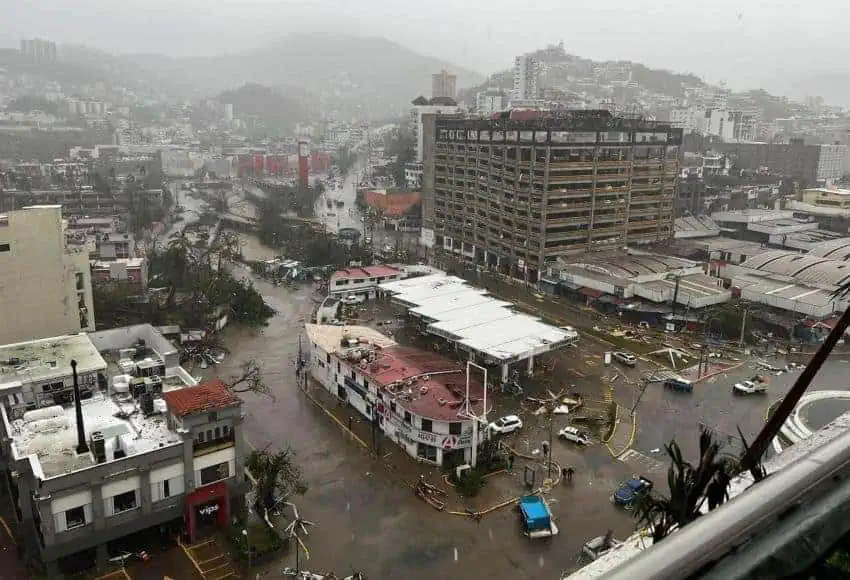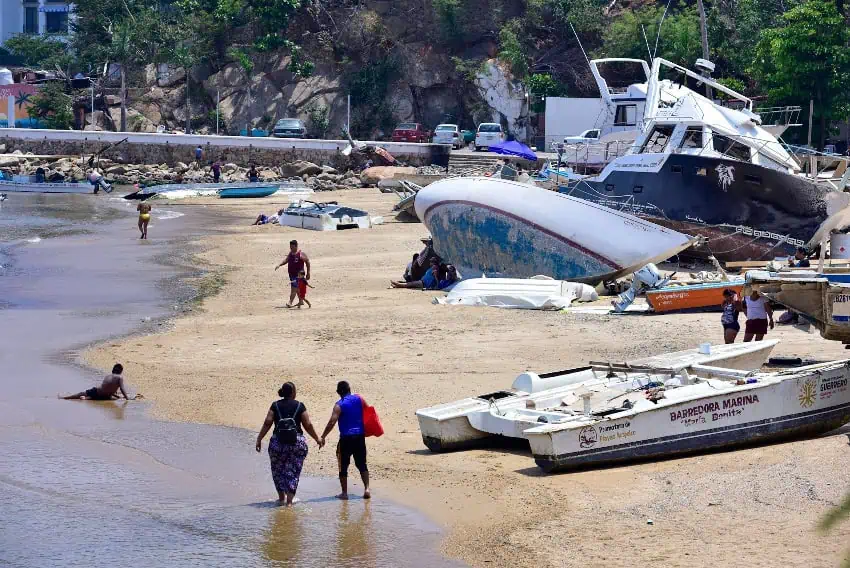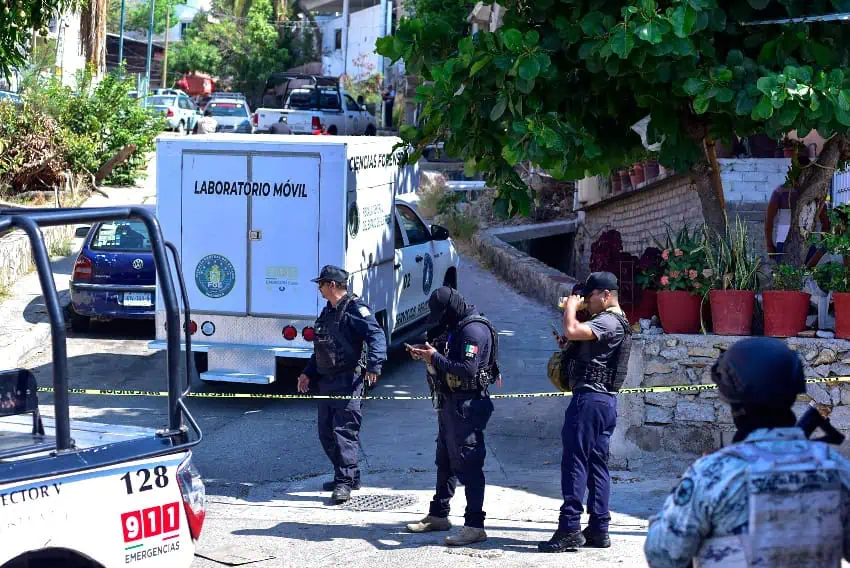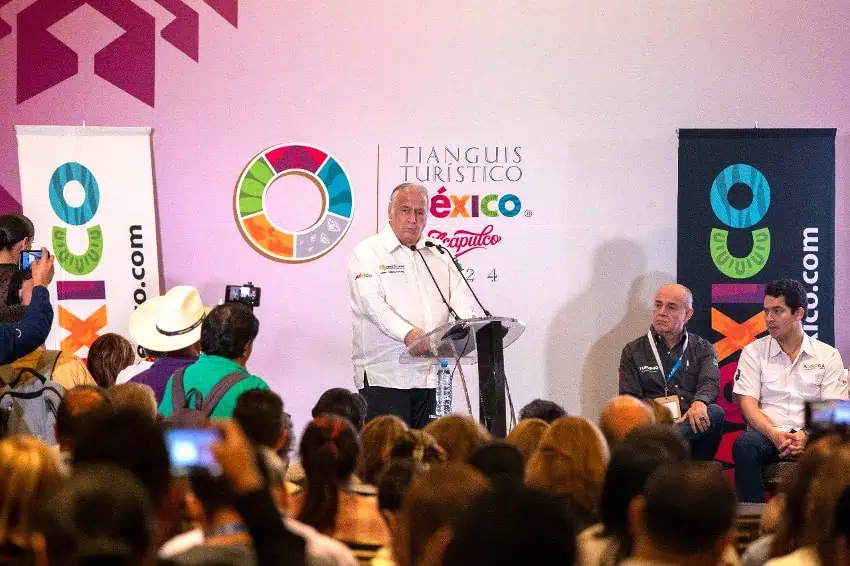Almost six months after Hurricane Otis, the recovery in Acapulco is still far from complete.
The Category 5 storm — the strongest ever to hit Mexico’s Pacific coast — devastated the resort city on Oct. 25 and claimed at least 50 lives.

Major events have since returned to Acapulco: a professional tennis tournament in late February and March; Latin America’s largest tourism fair last week; Mexico’s annual Banking Convention this week; and regular sol y playa (sun and beach) tourism has made something of a comeback.
But a report published by the Bloomberg news agency on Wednesday paints a rather depressing picture of the situation in the destination that once welcomed Hollywood’s brightest stars. The Expansión news website said in another report that “the port of Acapulco is still fighting to recover” from the devastation caused by Otis late last year.
What’s the current situation in Acapulco?
Bloomberg described “a grim scene” in the city, reporting that most hotels and condo buildings along Acapulco’s beaches are “abandoned, with missing facades and swimming pools full of muck.”
However, plenty of Acapulco hotels have, in fact, reopened: Tourism Minister Miguel Torruco reported in mid-February that the port city had 7,110 rooms available in 167 hotels, and more than 2,000 additional rooms have reopened since then.
Still, the capacity of Acapulco hotels is less than 50% what it was previously, noted Cancún-based tourism academic Francisco Madrid, who was quoted in Bloomberg’s report.
Bloomberg also reported that “more than half the city’s traffic lights aren’t working, streets are cluttered with trash and washed-out roads have left some areas inaccessible.”

In addition, the news agency said that “many upscale restaurants are shut, and the marina is still filled with half-sunk yachts and other debris.”
Expansión reported Wednesday that “signs of destruction” from Otis are still visible in Acapulco and that “the accumulation of trash in the streets and the slowness of the recovery” are testament to the “long road” ahead.
The news website also noted that Otis dealt a heavy blow to the local economy. Citing official data, Expansión said that Acapulco’s contribution to Guerrero’s tourism revenue has declined to 23% from 65% before the hurricane.
Crime and dengue
Looting was a major problem in the days after Otis hit Acapulco. Now, gangs involved in that looting “remain in control of large parts of the city, mostly outside tourist areas,” Bloomberg reported.
Extortion is a major problem in the city, according to the president of a local business association, and homicides are quite common as well. In one attack last week, the head of the Acapulco traffic police was murdered.
Acapulco has also suffered from a dengue outbreak this year with thousands of cases in the city and other parts of Guerrero. Bloomberg reported that destruction caused by Otis curtailed mosquito fumigation efforts in the city.
The reconstruction efforts
President Andrés Manuel López Obrador announced a 61.3-billion-peso (US $3.6 billion) recovery plan for Acapulco and the neighboring municipality of Coyuca de Benítez a week after Otis slammed into the Guerrero coast.
Four months later in February, Tourism Minister Torruco said that the recovery was going faster than expected.
However, only 9,500 of 21,000 hotel rooms that were open before Otis are currently able to receive guests. In other words, 55% of rooms remain closed.
Citing government figures, Bloomberg reported that insurance companies have only paid out 9 billion pesos (about US $530 million) to property owners, even though the cost of damage was estimated at US $15 billion or higher. Insurers are eventually expected to pay out around US $2 billion, according to the Mexican Association of Insurance Institutions.

Meanwhile, private investment “has so far fallen well short of what’s needed to revitalize the city,” Bloomberg said.
Carlos Slim, Mexico’s richest person, is completing work on his Calinda Beach Hotel and has attempted to get “others to invest in Acapulco,” the news agency said before noting that he has “had little luck so far.”
However, the hotel sector is not without optimism. The CEO of Mundo Imperial, which owns and operates three five-star hotels in Acapulco, told Bloomberg that “Acapulco is going to come back better than ever.”
“We will have a sustainable Acapulco, with better facilities for all the hotels,” said Seyed Rezvani.
But if a “better than ever” Acapulco is possible, it’s clear that its creation is yet some ways off.
In addition to hotels, several other commercial establishments and homes — tens of thousands of which were damaged by Otis – are still awaiting repairs. In many cases, it is unclear when repair work will begin, let alone end.

Expansión noted that there are abandoned residential complexes for which no dates for repair work have been set.
While many existing properties await repair, some new ones are being built, including five projects of the Mexican real estate development company Ayya.
“With all the buildings that were destroyed, the demand for new apartments is going to be much higher,” Manuel Athie, a real estate agent with the company, told Bloomberg.
“If we are one of the few companies offering apartments, we will have a great advantage,” he said.
How are tourism-dependent acapulqueños coping?
Bloomberg spoke to a number of acapulqueños, as Acapulco residents are known, including Ofe Quiros, a silver jewelry vendor in the city’s main square.
“We depend on tourism, and people are not coming back,” she said.

Quiros said she received a 35,000-peso (about US $2,000) grant from the government but noted that it was insufficient to repair the roof and a wall of her home that were damaged in the powerful hurricane.
Life is also tough for Grisanta Sánchez, a 65-year-old hat vendor who on a recent day spent more than six hours on mostly empty beaches. She didn’t make a single sale, according to Bloomberg’s report.
Rosa, a woman in her 50s who braids tourists’ hair and offers massages on the beach, told Expansión she was confident that tourists would begin to return to Acapulco in greater numbers. She said that visitor numbers have increased gradually but that demand for her services — and her earnings — are still well below pre-hurricane levels.
A unidentified grill chef at a local buffet restaurant told Expansión that many tourism and hospitality workers have relocated to other destinations due to the lack of tourists in Acapulco.
“A lot have gone to Los Cabos or Cancún so as not to lose their source of income because work is limited here,” he said. “… I want to go as well, but my wife is sick and just had surgery, so we first have to wait for her to recover,” the chef said.
Expansión reported that tourism sector workers expect it will take around two years for Acapulco to recover from the impact of Hurricane Otis.

However, the Guerrero branch of the Mexican Association of Travel Agencies (AMAV) says that all 21,000 hotel rooms in Acapulco will be ready to receive guests six months from now. Filling them, however, could be a challenge, and local AMAV chief Leví Williams Manzanares predicts that it will take hoteliers an average of three years to recoup their investment in reconstruction work, even as they raise room rates by an expected 10–30%.
A local taxi driver told Expansión he was hopeful that the reopening of nightclubs would help to attract more visitors.
“Currently not even Baby’O is open,” he said, referring to the iconic nightclub that was destroyed by fire in 2021. The club did, however, open during last week’s Tianguis Turístico, when attendees from around Mexico and more than 40 countries descended on Acapulco.
Torruco: tourism fair showed that Acapulco is “being reborn”
There is no doubt that last week’s Tianguis Turístico gave a significant boost to the tourism sector in Acapulco — and the city more broadly.
The Tourism Ministry (Sectur) reported that the hotel occupancy rate during the event was 79.6%, a figure based on the availability of 9,500 rooms. Spending on accommodation and tourism services exceeded 1 billion pesos (US $58.9 million) during the week, according to Sectur.
In a speech at the event’s conclusion, Torruco declared that with the staging of the annual Tianguis Turístico, authorities achieved their “objective” of “showing that Acapulco is on its feet and being reborn in order to once again be a great national and international destination.”
The city will also get a boost from the National Banking Convention, which will take place this Thursday and Friday. Mexico’s three presidential candidates, Claudia Sheinbaum, Xóchitl Gálvez and Jorge Álvarez Máynez, will all speak at the event, which will be held at the Palacio Mundo Imperial hotel.
With reports from Bloomberg, Expansión and El Financiero
